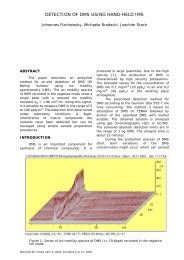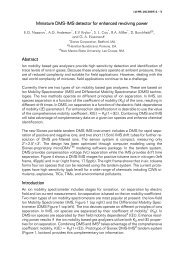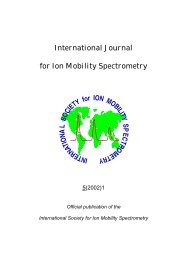An Automatic Trace Detection System for the Detection of Explosives ...
An Automatic Trace Detection System for the Detection of Explosives ...
An Automatic Trace Detection System for the Detection of Explosives ...
You also want an ePaper? Increase the reach of your titles
YUMPU automatically turns print PDFs into web optimized ePapers that Google loves.
<strong>An</strong> <strong>Automatic</strong> <strong>Trace</strong> <strong>Detection</strong> <strong>System</strong> <strong>for</strong> <strong>the</strong> <strong>Detection</strong> <strong>of</strong> <strong>Explosives</strong>’<br />
Vapours and Particles in Luggage<br />
L. Fricano, M. Goledzinowski, R. Jackson, F. Kuja, L. May, S. Nacson<br />
Barringer Research Limited, 1730 Aimco Blvd., Mississauga, Ontario, L4W 1V1<br />
Abstract<br />
Barringer has designed and engineered an <strong>Automatic</strong> <strong>Trace</strong> Detector (ATD) to sample<br />
luggage <strong>for</strong> explosive particles and vapours, using advanced high volume pre-concentration<br />
and detection systems. The ATD has been designed and developed under funding from <strong>the</strong><br />
US Federal Aviation Administration (FAA). Barringer’s design provides speed, sensitivity,<br />
robustness and ease <strong>of</strong> servicing, while minimizing chemical interferences.<br />
The ATD screens checked luggage <strong>for</strong> explosives by collecting both particles and vapours.<br />
The item being checked enters <strong>the</strong> first <strong>of</strong> two chambers, where sampling tubes scrape,<br />
dislodge and collect any surface particulates, and transport <strong>the</strong>m to a 2-stage preconcentrator,<br />
and <strong>the</strong>n to an IMS detector. The bag <strong>the</strong>n enters <strong>the</strong> second chamber,<br />
where it is mechanically burped to expel explosive vapours, which are transported to an<br />
identical 2-stage pre-concentrator, and <strong>the</strong>n analysed by its’ associated IMS. The system<br />
utilizes two separate IMS detectors, one optimized <strong>for</strong> particles and <strong>the</strong> o<strong>the</strong>r <strong>for</strong> vapours.<br />
This dual IMS arrangement <strong>of</strong>fers increased speed <strong>of</strong> analysis <strong>for</strong> each item, as <strong>the</strong> system<br />
has <strong>the</strong> capability to screen over 700 bags per hour. The novel engineering features <strong>of</strong> <strong>the</strong><br />
ATD will be presented.<br />
Introduction<br />
<strong>Detection</strong> <strong>of</strong> explosives concealed in luggage is a continuous challenge to airport security<br />
personnel. Presently, checked luggage is x-rayed, and any suspicious pieces are pulled<br />
from <strong>the</strong> conveyor and tested separately. The US Federal Aviation Administration, FAA,<br />
funded Barringer Instruments to develop an <strong>Automatic</strong> <strong>Trace</strong> Detector, ATD, screening<br />
system to enable <strong>the</strong>m to rapidly screen baggage <strong>for</strong> traces <strong>of</strong> explosives. Barringer was<br />
chosen to engineer a commercial, reliable system using <strong>the</strong>ir well-proven IONSCAN<br />
technology, in concert with a novel pre-concentration technique, which was developed by<br />
Sandia National Laboratories, and licensed to Barringer.<br />
Details<br />
The complete system is shown schematically in Figure 1. It consists <strong>of</strong> two discrete<br />
contiguous sampling “tunnels”, mounted over a branch conveyor belt, <strong>the</strong> 1 st is <strong>for</strong> collection<br />
<strong>of</strong> particles present on exterior surfaces <strong>of</strong> luggage, and <strong>the</strong> 2 nd is <strong>for</strong> sampling luggage<br />
interiors <strong>for</strong> vapours.<br />
As luggage enters <strong>the</strong> ATD, a series <strong>of</strong> mechanical and optical sensors relay in<strong>for</strong>mation on<br />
its length, width, height and shape to position <strong>the</strong> sampling manifolds correctly over <strong>the</strong><br />
luggage <strong>for</strong> optimum collection <strong>of</strong> particles.<br />
The particle unit consists <strong>of</strong> 3 sampling manifolds, or banks, containing a total <strong>of</strong> 225 flexible<br />
tubes that “pick up” and transport <strong>the</strong> particles to <strong>the</strong> primary pre-concentrator. Just after<br />
<strong>the</strong> luggage enters <strong>the</strong> sampling tunnel, a hinged mechanical “pusher” positions <strong>the</strong> luggage<br />
horizontally against <strong>the</strong> stationary left side sampling bank, while <strong>the</strong> top and right side banks<br />
are positioned by <strong>the</strong> CPU logic/mechanical links. When positioned correctly, <strong>the</strong> sampling<br />
22
tubes contact <strong>the</strong> luggage surfaces, and flex slightly. The 2 moveable banks are agitated<br />
lightly over <strong>the</strong> luggage, using a lateral motion to “brush” <strong>the</strong> surfaces, and dislodge any<br />
particles. Concurrently, a high-suction airflow <strong>of</strong> 4,500 l/min (20 l/min/tube) is initiated,<br />
which transfers <strong>the</strong> particles to <strong>the</strong> primary pre-concentrator, a tortuous-path stainless steel<br />
screen mesh, which efficiently traps and absorbs particles.<br />
Feeder Belt<br />
SYSTEM OPERATION CONCEPT DIAGRAM<br />
Jam Detector<br />
Main Belt<br />
Oversize Detector<br />
Luggage Size/Position<br />
Sensors (insidde tunnel)<br />
Sampling Tunnels<br />
Particles<br />
Sandia preconcentrator<br />
Heat<br />
Vapors<br />
Coated mesh<br />
Vapor Concentrator<br />
Heat<br />
Vapors<br />
Logic<br />
Controller<br />
IONSCAN ®<br />
IMS<br />
Vapors<br />
Sandia preconcentrator<br />
Vapors<br />
Coated mesh<br />
Vapor Concentrator<br />
Vapors<br />
IONSCAN ®<br />
IMS<br />
Reject Belt/Shute<br />
Alarms<br />
Main Belt<br />
Figure 1:<br />
ATD Schematic<br />
After sample collection, <strong>the</strong> pre-concentrator housing is sealed, and a cross-flow <strong>of</strong> clean air<br />
initiated, while simultaneously <strong>the</strong> mesh is resistively heated <strong>for</strong> 1.5 seconds using a<br />
trans<strong>for</strong>mer. All traces <strong>of</strong> explosive particles absorbed on <strong>the</strong> mesh are flash-vaporized into<br />
<strong>the</strong> clean, cross-flow air stream, <strong>the</strong>n absorbed in a proprietary secondary concentrator,<br />
mounted in a rotating table. The cross-flow air stops, and <strong>the</strong> table rotates and positions <strong>the</strong><br />
cartridge directly underneath <strong>the</strong> IONSCAN inlet. The cartridge is <strong>the</strong>n sealed in <strong>the</strong> inlet,<br />
and heated to vapourise <strong>the</strong> absorbed analyte directly into <strong>the</strong> IMS (Figure 2). This<br />
secondary concentration/ vapourization cycle transfers a much cleaner sample into <strong>the</strong><br />
IONSCAN, minimising interference, and reducing <strong>the</strong> amount <strong>of</strong> background matrix entering<br />
<strong>the</strong> IMS and contaminating it.<br />
23
A similar technique is employed <strong>for</strong> sampling <strong>for</strong> vapours. Immediately after particle<br />
sampling, <strong>the</strong> luggage enters <strong>the</strong> vapour tunnel. A high suction airflow is turned on, and a<br />
mechanical inclined 3-pronged bar descends, pressing down physically on <strong>the</strong> luggage and<br />
“burping” it to release any explosive vapours that are present in <strong>the</strong> interior. All <strong>the</strong> air in <strong>the</strong><br />
tunnel is effectively sampled by <strong>the</strong> powerful suction flow.<br />
The suctioned air stream passes through <strong>the</strong> primary pre-concentrator, where <strong>the</strong> vapours<br />
are absorbed. The next steps are identical to <strong>the</strong> particle system, i.e. cross-flow air, rapid<br />
mesh heating, absorption into <strong>the</strong> secondary concentrator, and from <strong>the</strong>re, <strong>the</strong>rmal<br />
desorption into <strong>the</strong> IONSCAN <strong>for</strong> analysis (Figure 3).<br />
The complete system is capable <strong>of</strong> processing approximately 700 pieces <strong>of</strong> luggage per<br />
hour. A timing diagram (Figure 4) shows <strong>the</strong> sequence <strong>of</strong> events.<br />
Figure 2: Particle collection, 2-stage concentration and IMS analysis<br />
PARTICLE SAMPLING SYSTEM<br />
AC Heater Power<br />
AC Heater Power<br />
Sandia Preconcentrator<br />
Primary Pre-concentrator<br />
Cartridge<br />
Particles<br />
Vapors Vapors<br />
IONSCAN ®<br />
IMS Detector<br />
Moveable Moveable Sampling Sampling<br />
Tube Tube Manifolds Manifold<br />
Secondary<br />
Vapor Coated Concentrator Mesh<br />
Vapor Concentrator<br />
Rotary<br />
Table<br />
P1<br />
P2<br />
Luggage<br />
Sampling Tubes<br />
Suction Tubes<br />
Figure 3: Vapour collection, 2-stage concentration and IMS analysis<br />
24
100<br />
cm<br />
Bag<br />
1<br />
150<br />
cm<br />
Bag<br />
2<br />
Bag<br />
3<br />
Bag<br />
4<br />
Bag<br />
5<br />
Bag<br />
6<br />
2 s<br />
3 s 2 s 3 s 2 s 3 s 2 s 3 s<br />
S<br />
D & RT<br />
PDA<br />
20 sec<br />
Figure 4:<br />
Timing sequence<br />
Summary <strong>of</strong> Events Timing<br />
Sampling (S)<br />
7 sec<br />
Desorption and Maximum bag size 75 x 75 x 100 cm<br />
Rotation <strong>of</strong> Table (D & RT) 3 sec Bag throughput rate 720/hour or 1/5 sec<br />
Particle Desorption Conveyor belt speed 50 cm/sec<br />
and <strong>An</strong>alysis (PDA) 10 sec IMS rate 6 samples/min<br />
Total Cycle<br />
20 sec<br />
The IONSCAN operating parameters <strong>for</strong> particles and vapours were:<br />
Particles Vapours<br />
IMS drift tube temperature ( o 115 60<br />
C)<br />
Inlet temperature ( o C) 245 110<br />
VAPOR SAMPLING SYSTEM<br />
AC Heater Power<br />
AC Heater Power<br />
Vapors<br />
Sandia<br />
Sandia<br />
Preconcentrator<br />
Preconcentrator<br />
Cartridge<br />
Cartridge<br />
Vapors Vapors<br />
IONSCAN ®<br />
IMS Detector<br />
Moveable Tube<br />
Manifold Moveable ”Burper”<br />
Manifold<br />
Coated Mesh<br />
Vapor Coated Concentrator Mesh<br />
Vapor Concentrator<br />
Mechanical “burper” bar<br />
Rotary<br />
Table<br />
Luggage<br />
P1<br />
P2<br />
Suction exit<br />
Suction Tubes<br />
Sampling Plenum<br />
Drift gas flow rate (ml/min) 350 350<br />
Sample gas flow rate (ml/min) 300 300<br />
25
Conclusions<br />
Barringer has developed and built a novel, effective <strong>Automatic</strong> <strong>Trace</strong> Detector <strong>for</strong> <strong>the</strong> rapid<br />
screening <strong>of</strong> luggage <strong>for</strong> traces <strong>of</strong> explosives' vapours and particles.<br />
Future developments will focus on fur<strong>the</strong>r optimization <strong>of</strong> <strong>the</strong> primary pre-concentrator <strong>for</strong><br />
vapour analysis, and overall improvements to <strong>the</strong> flow dynamics <strong>of</strong> <strong>the</strong> system. A final<br />
assessment <strong>for</strong> false alarm rates in a real-world, busy airport environment is planned when<br />
<strong>the</strong> complete system is optimized.<br />
26
















